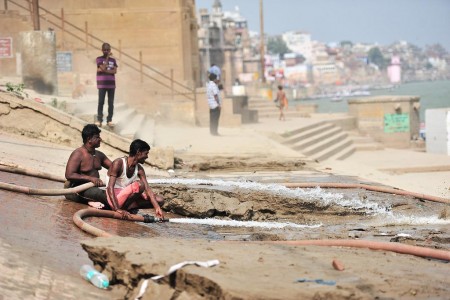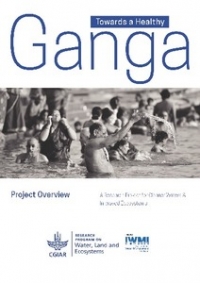To hundreds of millions of Indians, the Ganges is not just a river but a holy blessing, flowing a nectar (amrit) of self-purifying water from the Himalayas to the Bengal Bay. Yet, the Ganges has seen drastic water degradation over decades, struggling with water diversion for non-efficient irrigated agriculture and a daily discharge of more than two billion litres of untreated sewage.
The Namami Ganga programme (National Mission for Clean Ganga) launched in 2014 by the current Indian government, with an allocated budget of over 3 billion US$ over 5 years, follows in the footsteps of a 30 year-long ecological battle to restore the Ganges water quality, with mixed results. Political and media attention is on iconic pollution hot spots like the leather tanning industry capital town of Kanpur and the sacred Hindu city of Varanasi. Much of the Namami Ganga investment will be directed towards constructing new modern sewage treatment plants in the main cities along the Ganga. Yet, new research from the Water, Land and Ecosystems Program led by IWMI highlights the urgent and equally important need to tackle the growing septage pollution load from the smaller cities along the Ganges which typically receive less attention.

Reducing urban fecal pollution is the top priority to improve Ganga water quality
Mughalsarai, a fast-growing city of over 100,000 inhabitants located ten miles from Varanasi, is a good illustration of the situation of about one hundred small and medium sized cities along the Ganges. Here, Mughalsarai harbours a hygiene problem. An extensive household survey found out that about a third of households practice open defecation which ultimately contaminates the Ganges waters. The remaining households, while equipped with toilets, still generate significant fecal pollution as none of them are designed to safely empty and treat the resulting septage, which instead overflows untreated through clogged open drains.
Environmental pollution will not improve only by building toilets with the implementation of Swachh Bharat Mission, the flagship programme of the Indian government that aims to achieve an open defecation-free India by October 2, 2019, the 150th birthday anniversary of Mahatma Ghandi. Toilet waste needs to be safely treated before disposal or reuse.
“Significant fecal pollution in the Ganges is revealed by high coliform levels which make the water unsuitable for bathing and drinking or even for irrigation of vegetables to be eaten raw,” explains Javier Mateo-Sagasta, senior researcher with the International Water Management Institute (IWMI).
A report on the pollution load in the Ganga, prepared by the Central Pollution Control Board in 2013, states that every day, more than 6,000 million litres of wastewater flows into the Ganga from 138 drains. Experts say domestic sewage is a major constituent of this wastewater. Fecal pollution is aggravated during the monsoon, with average concentration of fecal coliforms significantly higher than in the dry period. This reflects large scale uncontrolled pollution sources like sludge dumping and open defecation.
“Unfortunately, fecal sludge and septage management (FSSM) are not mentioned in sanitation programmes like Swachh Bharat Mission,” says Suresh Kumar Rohilla, programme director of urban water management unit at the Center for Science and Environment (CSE). By not including FSSM, the National Mission for Clean Ganga is missing a large part of the pollution problem.

Cost effective and sustainable solutions for Mughalsarai and consorts
In a new policy brief, WLE researchers advise cities like Mughalsarai, who do not have a functional sewerage system in place, to invest in decentralised and in-situ sanitation solutions such as drain cleaning and co-composting of septate together with other organic wastes. These smaller scale efforts will cost much less than setting up a complex sewerage system and associated treatment plant, and will be easier to operate. Mechanical transport of septage is 10 to 20 times cheaper than setting up a sewerage network according to the study’s calculations.
Costs of treating households and municipal fecal sludges (FS) could be partially recovered. FS co-composting units would produce organic fertilizer pellets which could be sold to urban vegetable growers as seen in Ghana or Bangladesh. In Mughalsarai, a fecal sludge management unit dimensioned to treat the septage from the 16,000 households would generate about 9 tons of compost a day. With the sale of compost to local farmers, the user charge per household would be reduced from 90 to 65 INR per month.
Fecal sludge management can be complemented with centralized or decentralized wastewater treatment from open drains. When land is not available for treatment plants, floating wetlands within large drains have proved to improve water quality. These floating wetlands mimic ecosystems and host filtering plants and attached microorganism to treated polluted waters.
A concrete step towards regaining the health of the Ganges would be to support the construction of a pilot fecal sludge management unit in Mughalsarai or similar sized city, which would demonstrate the feasibility and sustainability of the options mentioned above and favour its replication at scale.
The Ganges deserves a better coordination of funds and sanitation initiatives as well as a massive public awareness campaign to consider all individual and corporate efforts to reduce pollution. Small streams form great rivers, and so restoring the water quality of the Ganges will only happen with the cooperation of everybody, from small to big, along the revered river.
Read more on Healthy Ganga recommendations:
Article: Read the recent Down-to-Earth report “Pipe dream” about the importance of proper domestic faecal sludge management to ensure a Clean Ganga.
Video: Cleaning the Ganga
Policy Brief: Reducing fecal pollution in small and medium-size cities along the Ganga River









